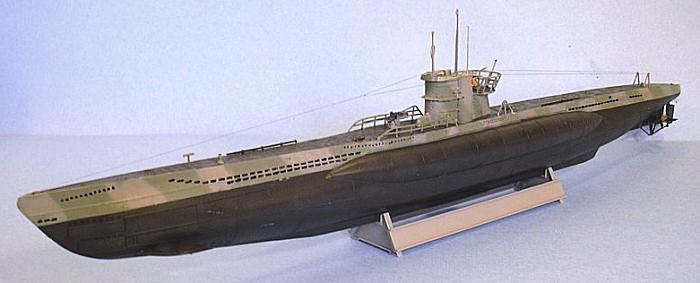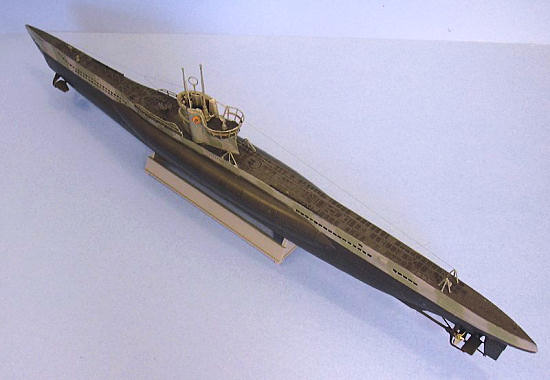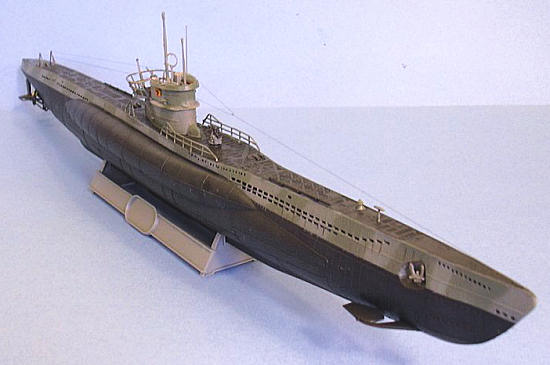
Revell 1/144 Type VIID U-boat
| KIT: | Revell 1/144 Type VIID U-boat |
| KIT #: | ? |
| PRICE: | $29.95 MSRP |
| DECALS: | Four options |
| REVIEWER: | Tom Cleaver |
| NOTES: |

| HISTORY |
The Type VII U-boat first appeared as the VIIA in 1936. While it was not the best submarine in any particular aspect, in all its variations it was the most successful submarine of the Second World War, forming the backbone of the U-boat force throughout the war.
The Type VII became the main craft of the U-boat force for two reasons.
The first was technical. The Type VII had the range, sea worthiness, armament,
and maneuverability to conduct an anti-shipping war in the North Atlantic.
Additionally, the Type VII was
 relatively
cheap and could be built quickly using mass-production techniques. Secondarily,
naval policy influenced the selection. Under the 1935 Anglo-German Naval
Agreement, Germany was allowed to construct submarines up to 35 percent the
tonnage of the Royal Navy submarine fleet, which was later increased to 100
percent. The Type VII, as a medium-tonnage boat, could be built in greater
numbers under these restrictions.
relatively
cheap and could be built quickly using mass-production techniques. Secondarily,
naval policy influenced the selection. Under the 1935 Anglo-German Naval
Agreement, Germany was allowed to construct submarines up to 35 percent the
tonnage of the Royal Navy submarine fleet, which was later increased to 100
percent. The Type VII, as a medium-tonnage boat, could be built in greater
numbers under these restrictions.
709 Type VII U-boats of all variants were built during the war, more than any other submarine type built by any other nation. The U-boat appeared in seven main variants: VIIA, VIIB, VIIC, VIIC/41, VIIC/42, VIID and VIIF.
 The
Type VIIC, which began appearing in 1940 with the launch of U-59, became the
backbone of the German U-boat fleet in the Battle of the Atlantic. It had
greater fuel capacity and therefore longer range than the Type VIIB U-boats
which had been fighting the Battle of the Atlantic to that point. Among the more
successful Type VIICs was U-201, commissioned on January 25, 1941 under the
command of Oberleutnant Adalbert Schnee, who sank 103,355 GRT of Allied
merchant shipping and two auxiliary warships for 5,700 GRT, over seven war
patrols that concluded with his transfer to the staff of the U-boat command on
August 24, 1943 by which time he had been promoted to Kapitaen-Leutnant.
The
Type VIIC, which began appearing in 1940 with the launch of U-59, became the
backbone of the German U-boat fleet in the Battle of the Atlantic. It had
greater fuel capacity and therefore longer range than the Type VIIB U-boats
which had been fighting the Battle of the Atlantic to that point. Among the more
successful Type VIICs was U-201, commissioned on January 25, 1941 under the
command of Oberleutnant Adalbert Schnee, who sank 103,355 GRT of Allied
merchant shipping and two auxiliary warships for 5,700 GRT, over seven war
patrols that concluded with his transfer to the staff of the U-boat command on
August 24, 1943 by which time he had been promoted to Kapitaen-Leutnant.
U-201 undertook two more war patrols under the command of Kapitaen-Leutnant Gunther Rosenberg, without success. Caught east of Newfoundland by HMS Fame on February 17, 1943, she was sunk by depth charges with the loss of all hands.
Schnee went on to become involved in the development of the Type XXI U-boats and commanded U-2511, the only Type XXI to undertake a war patrol before the end of the war.
| THE KIT |
 For
those who do not have 4 cubic linear feet of storage space to display a Revell
1/72 scale U-boat, this 1/144 Type VIIC is a good substitute. The kit has
excellent surface detail, having been pantographed down from the larger model.
The raised rivet and weld line detail looks very effective, while the deck is
slatted correctly and the drain holes are deep enough to look accurate. The kit
is relatively simple, with a total of 92 parts on three dark grey sprues. At an
overall length of approximately 19 inches, the kit is large enough to provide
good detail, without requiring a modeler add a new room to their house for
display.
For
those who do not have 4 cubic linear feet of storage space to display a Revell
1/72 scale U-boat, this 1/144 Type VIIC is a good substitute. The kit has
excellent surface detail, having been pantographed down from the larger model.
The raised rivet and weld line detail looks very effective, while the deck is
slatted correctly and the drain holes are deep enough to look accurate. The kit
is relatively simple, with a total of 92 parts on three dark grey sprues. At an
overall length of approximately 19 inches, the kit is large enough to provide
good detail, without requiring a modeler add a new room to their house for
display.
The instructions are very complete, providing alternative paint schemes and markings for four Type VIIC U-boats, including U-201.
| CONSTRUCTION |
A submarine is a good place to begin for someone returning to ship modeling, or just starting out, due to their basic simplicity. During construction of this kit, the only difficulty I experienced was cutting off various of the smaller parts from the sprue without damaging them. Some are small enough that damage is apparently inevitable. Even with all this, assembly of the hull took less than two hours.
 I
had decided to model U-201, so I then painted the hull, using Tamiya "NATO
Black" for the decks and the lower hull. The sides of the casing were painted
with Xtracrylix "Light Camouflage Grey" and "Dark Slate Grey" aircraft colors,
in accordance with the instructions to portray U-201 as she appeared when
serving with the 9th U-Flotille at Brest in 1941-42.
I
had decided to model U-201, so I then painted the hull, using Tamiya "NATO
Black" for the decks and the lower hull. The sides of the casing were painted
with Xtracrylix "Light Camouflage Grey" and "Dark Slate Grey" aircraft colors,
in accordance with the instructions to portray U-201 as she appeared when
serving with the 9th U-Flotille at Brest in 1941-42.
After everything was dry, I attached the conning tower, deck gun, and other deck fittings. I gave the hull and the conning tower parts a light coat of Tamiya "Smoke", which popped out the detail nicely and left the model with a "used" look. I then applied rust streaks with reddish-brown paint. When everything was assembled and detailed, the model was given an overall coat of Xtracrylix Flat Varnish. I finished off by making the running wires with invisible thread.
| CONCLUSIONS |
 Iíve
always liked submarines, particularly those of World War II. I think 1/144 is
the perfect for submarine models, being large enough to allow provision of good
detail, without being so big as to create storage and display problems once
finished. The model looks very good displayed with other 1/144 Type VIID and
Type XXI submarine models. While the kit looks good assembled out of the box,
aftermarket sets for the railings would result in an outstanding model, and
these are available from Eduard.
Iíve
always liked submarines, particularly those of World War II. I think 1/144 is
the perfect for submarine models, being large enough to allow provision of good
detail, without being so big as to create storage and display problems once
finished. The model looks very good displayed with other 1/144 Type VIID and
Type XXI submarine models. While the kit looks good assembled out of the box,
aftermarket sets for the railings would result in an outstanding model, and
these are available from Eduard.
Review kit courtesy of my wallet.
April 2008
If you would like your product reviewed fairly and fairly quickly, please contact the editor or see other details in the Note to Contributors.